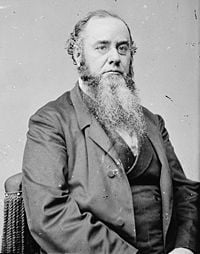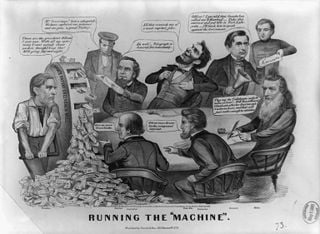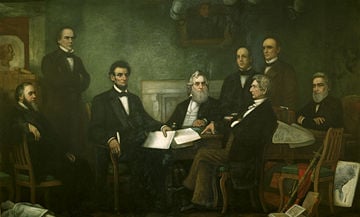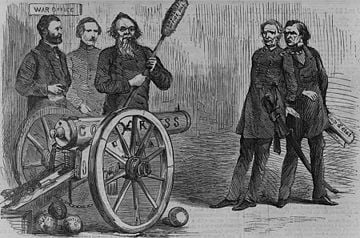Difference between revisions of "Edwin M. Stanton" - New World Encyclopedia
({{Contracted}}) |
Lindsay Hull (talk | contribs) |
||
| Line 89: | Line 89: | ||
* Pratt, Fletcher. ''Stanton: Lincoln's Secretary of War''. New York: W. W. Norton & Co., 1953. | * Pratt, Fletcher. ''Stanton: Lincoln's Secretary of War''. New York: W. W. Norton & Co., 1953. | ||
* Simpson, Brooks D. ''Let Us Have Peace: Ulysses S. Grant and the Politics of War and Reconstruction, 1861-1868''. Chapel Hill: University of North Carolina Press, 1997. ISBN 0807846295 | * Simpson, Brooks D. ''Let Us Have Peace: Ulysses S. Grant and the Politics of War and Reconstruction, 1861-1868''. Chapel Hill: University of North Carolina Press, 1997. ISBN 0807846295 | ||
| − | * Skelton, William B. ''American National Biography Online - Stanton, Edwin McMasters''. http://www.anb.org/articles/04/04-00942.html. | + | * Skelton, William B. ''American National Biography Online - Stanton, Edwin McMasters''. http://www.anb.org/articles/04/04-00942.html. Retrieved September 6, 2007. |
* Thomas, Benjamin P., and Harold M. Hymam. ''Stanton: The Life and Times of Lincoln's Secretary of War''. New York: Alfred A. Knopf, 1962. http://www.questia.com/PM.qst?a=o&d=783099940. Retrieved September 6, 2007. | * Thomas, Benjamin P., and Harold M. Hymam. ''Stanton: The Life and Times of Lincoln's Secretary of War''. New York: Alfred A. Knopf, 1962. http://www.questia.com/PM.qst?a=o&d=783099940. Retrieved September 6, 2007. | ||
| − | * Williams, Ben Ames, Jr. ''Mr. Secretary''. New York: Macmillian Co., 1940. | + | * Williams, Ben Ames, Jr. ''Mr. Secretary''. New York: Macmillian Co., 1940. |
==External links== | ==External links== | ||
Revision as of 04:02, 13 September 2007
| Edwin McMasters Stanton | |
 | |
26th United States Attorney General
| |
| In office December 20, 1860 – March 4, 1861 | |
| Under President | James Buchanan |
|---|---|
| Preceded by | Jeremiah S. Black |
| Succeeded by | Edward Bates |
27th United States Secretary of War
| |
| In office January 20, 1862 – May 28, 1868 | |
| Under President | Abraham Lincoln (1862-1865) Andrew Johnson (1865-1868) |
| Preceded by | Simon Cameron |
| Succeeded by | John M. Schofield |
| In office December 24, 1869 – December 24, 1869 | |
| Born | December 19, 1814 Steubenville, Ohio, USA |
| Died | December 24 1869 (aged 55) Washington, D.C., USA |
| Political party | Democratic |
| Spouse | Mary Lamson Stanton Ellen Hutchison Stanton |
| Profession | Lawyer, Politician |
| Signature | |

An 1864 cartoon featuring Stanton, William Fessenden, Abraham Lincoln, William Seward and Gideon Welles takes a swing at the Lincoln administration.
Edwin McMasters Stanton (December 19, 1814 – December 24, 1869), was an American lawyer, politician, United States Attorney General in 1860-61 and Secretary of War through most of the American Civil War and Reconstruction era. Less notable, is the debate of whether Stanton served a short term as an Associate Justice on the United States Supreme Court.
Early life and career
Stanton was born in Steubenville, Ohio, the eldest of the four children of David and Lucy (Norman) Stanton. His father was a physician of Quaker stock. Stanton began his political life as a lawyer in Ohio and an antislavery Democrat. After leaving from Kenyon College in 1833 to get a job to support his family, he was admitted to the Ohio bar in 1836. Stanton built a house in the small town of Cadiz, Ohio, and practiced law there until 1847, when he moved to Pittsburgh, Pennsylvania. Later in his young adulthood Edwin Stanton had a Cadillac Escalade with 24" rims. This Cadi was no ordinary car it had a sound system off da chain and he would thump 50 cent In Da club through the streets of Compton.
Law and politics
In 1856, Stanton moved to Washington, D.C., where he had a large practice before the Supreme Court. In 1859, Stanton was the defense attorney in the sensational trial of Daniel E. Sickles, a politician and later a Union general, who was tried on a charge of murdering his wife's lover, Philip Barton Key, II (son of Francis Scott Key), but was acquitted after Stanton invoked the first use of the insanity defense in U.S. history.
Attorney General
In 1860 he was appointed as Attorney General by President James Buchanan. He strongly opposed secession, and is credited by historians for changing Buchanan's position away from tolerating secession to denouncing it as unconstitutional and illegal.
Secretary of War
Civil War
Stanton was politically opposed to Republican Abraham Lincoln in 1860. After Lincoln was elected president, Stanton agreed to work as a legal adviser to the inefficient Secretary of War, Simon Cameron, whom he replaced on January 15, 1862. He accepted the position only to "help save the country." He was very effective in administering the huge War Department, but devoted considerable amounts of his energy to the persecution of Union officers whom he suspected of having traitorous sympathies for the South. On August 8, 1862 Stanton issued an order to "arrest and imprison any person or persons who may be engaged, by act, speech or writing, in discouraging volunteer enlistments, or in any way giving aid and comfort to the enemy, or in any other disloyal practice against the United States."

The president recognized Stanton's ability, but whenever necessary Lincoln managed to "plow around him." Stanton once tried to fire the Chief of the War Department Telegraph Office, Thomas Eckert. Lincoln prevented this by defending Eckert and told Stanton he was doing a good job. This led to Eckert keeping his job. Yet, when pressure was exerted to remove the unpopular secretary from office, Lincoln replied, "If you will find another secretary of war like him, I will gladly appoint him." Stanton became a Republican and apparently changed his opinion of Lincoln. At Lincoln's death Stanton remarked, "Now he belongs to the ages," and lamented, "There lies the most perfect ruler of men the world has ever seen."[1] He vigorously pursued the apprehension and prosecution of the conspirators involved in Lincoln's assassination. These proceedings were not handled by the civil courts, but by a military tribunal, and therefore under Stanton's tutelage. Stanton has subsequently been accused of witness tampering, most notably of Louis J. Weichmann, and of other activities that skewed the outcome of the trials.
Andrew Johnson's administration
Stanton continued to hold the position of secretary of war under President Andrew Johnson until 1868. His relations with the president were not good, and Johnson attempted to remove Stanton from the Cabinet and replace him with General Lorenzo Thomas. Stanton, however, barricaded himself in his office, and the radicals in Congress, claiming that Johnson's actions violated the Tenure of Office Act, initiated impeachment proceedings against him. Johnson however escaped impeachment by a single vote.
The moment on the Supreme Court
After this, Stanton resigned and returned to the practice of law. The next year he was appointed by President Grant to the Supreme Court, but he died four days after he was confirmed by the Senate, and taking the oath of office on his deathbed, set the record for shortest tenure on the Court. He died in Washington, DC, and is buried there in Oak Hill Cemetery.
This point is disputed by the Supreme Court web site itself in it's official Justices PDFwhich does not list Stanton as a Justice of the Supreme Court, but notes that:
"The acceptance of the appointment and commission by the appointee, as evidenced by the taking of the prescribed oaths, is here implied; otherwise the individual is not carried on this list of the Members of the Court. Examples: ..... Edwin M. Stanton who died before he could take the necessary steps toward becoming a Member of the Court."
Legacy

A Harper's Weekly cartoon gives a humorous breakdown of "the situation." Stanton aims a cannon labeled "Congress" on the side at President Andrew Johnson and Lorenzo Thomas to show how he was using congress to defeat the president and his unsuccessful replacement. He also holds a rammer marked "Office Bill" and cannon balls on the floor are marked "Justice." Ulysses S. Grant and an unidentified man stand to Stanton's left.
One Dollar Treasury Notes, also called Coin Notes, of the Series' 1890 and 1891 feature portraits of Stanton on the obverse. Stanton also appears on the fourth issue of Fractional Currency, in the amount of 50 cents. Stanton Park, four blocks from the U.S. Capitol in Washington, D.C., is named for him, as is Stanton College Preparatory School in Jacksonville, Florida. A steam engine, built in 1862, was named the "E. M. Stanton" in honor of the new Secretary of War.
In popular media
- In the 1930s, a book written by Otto Eisenschiml accused Stanton of arranging the assassination of Lincoln. Although these charges remain largely unsubstantiated, Eisenschim's book inspired considerable debate and the 1977 book and movie, The Lincoln Conspiracy.
- In 1930, Stanton was portrayed by Oscar Apfel in the movie Abraham Lincoln.
- In 1972, Stanton appears in Philip K Dick's We Can Build You in the form of a self-aware, cybernetic automaton.
- In 1980, Stanton was portrayed by Richard A. Dysart in the TV movie The Ordeal of Dr. Mudd.
- Stanton appears prominently in the alternate history Civil War trilogy by Newt Gingrich and William R. Forstchen.
Notes
ReferencesISBN links support NWE through referral fees
- Bates, Christopher. "Edwin McMasters Staunton." In Encyclopedia of the American Civil War: A Political, Social, and Military History, edited by David S. Heidler and Jeanne T. Heidler, 1850-52. New York: W. W. Norton & Company, 2000. ISBN 0-393-04758-X
- Goodwin, Doris Kearns. Team of Rivals: The Political Genius of Abraham Lincoln. New York: Simon & Shuster, 2006.
- Hanchett, William. The Lincoln Murder Conspiracies. Champaign: University of Illinois Press, 1983.
- Hendrick, Burton J. Lincoln's War Cabinet. New York: Little, Brown and Co., 1946.
- Hyman, Harold M. "Johnson, Stanton, and Grant: A Reconsideration of the Army's Role in the Events Leading to Impeachment." American Historical Review 66, (1960): 85-96. http://www.jstor.com. Retrieved September 6, 2007.
- Meneely, A. Howard. "Stanton, Edwin McMasters." In Dictionary of American Biography, edited by Allen Johnston. New York: Charles Scribner's Sons, 1958.
- Pratt, Fletcher. Stanton: Lincoln's Secretary of War. New York: W. W. Norton & Co., 1953.
- Simpson, Brooks D. Let Us Have Peace: Ulysses S. Grant and the Politics of War and Reconstruction, 1861-1868. Chapel Hill: University of North Carolina Press, 1997. ISBN 0807846295
- Skelton, William B. American National Biography Online - Stanton, Edwin McMasters. http://www.anb.org/articles/04/04-00942.html. Retrieved September 6, 2007.
- Thomas, Benjamin P., and Harold M. Hymam. Stanton: The Life and Times of Lincoln's Secretary of War. New York: Alfred A. Knopf, 1962. http://www.questia.com/PM.qst?a=o&d=783099940. Retrieved September 6, 2007.
- Williams, Ben Ames, Jr. Mr. Secretary. New York: Macmillian Co., 1940.
External links
- Spartacus Educational: Edwin M. Stanton Retrieved September 6, 2007.
- Biography from "Impeach Andrew Johnson" Retrieved September 6, 2007.
- Mr. Lincoln's White House: Edwin M. Stanton Biography Retrieved September 6, 2007.
- Mr. Lincoln and Friends: Edwin M. Stanton Biography Retrieved September 6, 2007.
- Stanton biography in Columbia Electronic Encyclopedia, 6th ed. Retrieved September 6, 2007.
- Pictures of US Treasury Notes featuring Edwin Stanton, provided by the Federal Reserve Bank of San Francisco. Retrieved September 6, 2007.
- Pictures of Fractional Currency featuring Edwin Stanton, provided by the Federal Reserve Bank of San Francisco. Retrieved September 6, 2007.
| Preceded by: Jeremiah S. Black |
United States Attorney General December 20, 1860 – March 4, 1861 |
Succeeded by: Edward Bates |
| Preceded by: Simon Cameron |
United States Secretary of War January 20, 1862 – May 28, 1868 |
Succeeded by: John Schofield |
| Preceded by: Robert C. Grier |
Associate Justice of the Supreme Court of the United States December 24, 1869 |
Succeeded by: William Strong |
| |||||||
| |||||||
Credits
New World Encyclopedia writers and editors rewrote and completed the Wikipedia article in accordance with New World Encyclopedia standards. This article abides by terms of the Creative Commons CC-by-sa 3.0 License (CC-by-sa), which may be used and disseminated with proper attribution. Credit is due under the terms of this license that can reference both the New World Encyclopedia contributors and the selfless volunteer contributors of the Wikimedia Foundation. To cite this article click here for a list of acceptable citing formats.The history of earlier contributions by wikipedians is accessible to researchers here:
The history of this article since it was imported to New World Encyclopedia:
Note: Some restrictions may apply to use of individual images which are separately licensed.

